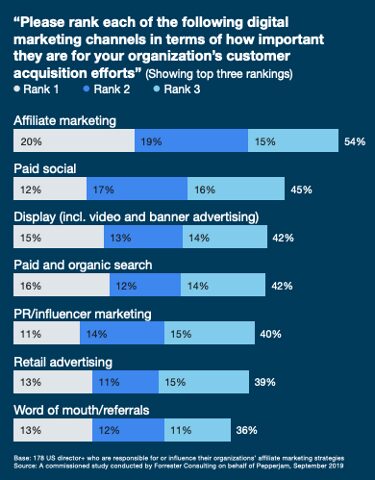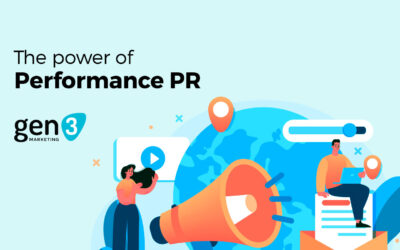How to Build an Effective Affiliate Marketing Funnel
An affiliate marketing funnel is one of the most effective ways to attract leads and generate sales. Learn how to build a powerful funnel step-by-step.

As the pace of online commerce accelerates, one channel stands out for its potential to drive performance-based growth: affiliate marketing. The secret to tapping into this potential? A well-designed, data-driven affiliate marketing sales funnel.
By 2027, the global affiliate marketing industry is forecasted to balloon to a staggering market size of $27.78B. Behind this eye-opening figure lies a landscape ripe with opportunities for brands ready to venture beyond traditional marketing tactics.
But what if we told you there’s a way to ensure your brand doesn’t just ride this wave but harnesses its force to generate exponential returns?
Enter the power of an optimized affiliate marketing funnel.
As the world’s most experienced affiliate marketing agency, Gen3 understands how a robust sales funnel can impact a brand’s ecommerce strategy. We’ve seen firsthand how this approach can drive traffic, build trust, improve conversion rates, and generate higher commission rates while lowering customer acquisition costs.
In this article, we’ll break down the nuts and bolts of creating a powerful affiliate marketing affiliate marketing funnel. Whether you’re a seasoned CMO seeking to optimize your existing program, a marketing director planning to launch a new initiative, or a small business or startup looking to dip your toes into affiliate networks, we’ll provide you with the insights and strategies to excel in today’s dynamic affiliate marketing landscape.
At Gen3, we know that a successful affiliate marketing program isn’t just about selling quality products—it’s about leveraging the right strategies to connect those products with the people who want them most, regardless of your business model. You want your customers to become ambassadors for your brand. That’s the dream.
Read on to learn how to revolutionize your approach to affiliate marketing and boost the overall performance of your marketing campaigns:
- The Benefits of an Affiliate Marketing Sales Funnel
- The Stages of an Affiliate Marketing Funnel
- Building a High-Performance Affiliate Marketing Funnel
- Igniting Your Brand’s Growth with an Effective Affiliate Marketing Funnel
The Game-Changing Benefits of an Affiliate Marketing Sales Funnel
Affiliate marketing funnels aren’t just another marketing buzzword—they’re a strategic approach to transforming casual browsers into committed buyers. Think of these funnels as a mapped journey, guiding potential customers from the first touchpoint with your brand right through to the final conversion.
But why should you, as a decision-maker in your organization, focus your efforts on optimizing your affiliate marketing funnel? Here are some of the compelling benefits:
Multiply Your Conversion Rates
Most consumers—up to 72%, according to Pardot—start their purchase journey with a search. If you rely solely on ads, you’re likely missing a significant portion of potential buyers. That’s where a well-structured affiliate marketing funnel steps in.
Picture this: you’re an online bookstore, and you’ve partnered with a popular book review blog. When readers finish a glowing review of a novel, they’re one click away from purchasing it from your store. This simplified journey from interest to purchase is the power of a well-crafted affiliate marketing funnel.
A robust affiliate marketing sales funnel streamlines the buyer’s journey by methodically guiding prospects from awareness to consideration to the final decision. It works to reduce friction and uncertainty, offering consumers a clear path to purchase and, in turn, significantly improving your conversion rates.
Enhance Brand Trust and Authority
The benefits of an affiliate marketing sales funnel don’t end with conversions. It’s also a powerful tool for bolstering your brand’s trust and authority. AWIN & Digiday report that 60% of brands attribute their lead conversion success to affiliate marketing.
When reputable affiliates promote your products, it lends credibility to your brand. As these influencers and publishers have established trust with their audiences, their referrals carry weight. This translates to enhanced brand perception and consumer trust, strengthening your brand’s authority in the marketplace.
Expand Your Reach

Affiliate marketing funnels also enable brands to reach a wider audience. By leveraging the unique audiences of different affiliates, you can effectively extend your reach far beyond what traditional marketing channels or beginner efforts allow.
For example, an emerging tech gadget brand can tap into the followers of tech bloggers, gaming influencers, and even lifestyle vloggers who enjoy featuring the latest gadgets on their YouTube channels.
A Forrester study shows that affiliate marketing is the most critical customer acquisition channel for 20% of brand marketers, and 54% rank it among their top three channels. This outperforms organic and paid search (16%) and display ads (15%). With such impressive statistics, it’s clear that the potential of affiliate marketing funnels to broaden your audience reach is unrivaled.
Embracing an affiliate marketing funnel is not just about achieving better performance today—it’s about setting your brand up for success in the long term. As the industry landscape evolves, a well-crafted, optimized affiliate marketing funnel can serve as a cornerstone of your ecommerce strategy.
Tired of spinning your wheels when it comes to your affiliate program?

Boost Your Commissions
A well-executed affiliate marketing funnel doesn’t merely drive conversions—it propels commissions. Imagine you’re a sustainable clothing brand partnered with eco-conscious fashion bloggers. By aligning your products with affiliates that share your target audience’s values and interests, you’re more likely to generate interest and, ultimately, sales. The result? A healthier bottom line. Remember, affiliate marketing funnels aren’t about casting a wider net but a smarter one. This approach targets not just more consumers but the right consumers, leading to higher-quality leads and, consequently, higher commissions.Stages within an Affiliate Marketing Funnel
Creating a high-performing affiliate marketing funnel is an intricate, personalized process. It requires in-depth audience knowledge, the ability to produce captivating, quality content, and a commitment to ongoing performance evaluation and optimization. Each step in this process is crucial for funnel success.
Let’s dig deeper into what each step entails with examples of affiliate marketing in action:
1: Building Awareness
The first step in creating an effective sales funnel is building awareness about your affiliate products or services. It’s all about capturing the attention of your target audience and drawing them into your funnel.
Content marketing and search engine optimization (SEO) play a crucial role here. With engaging, informative content that resonates with your audience—and is strategically optimized for search engines—you can effectively raise brand awareness.
If your audience spends the majority of their time on social media platforms, you’ll need to include those in your digital marketing plans.
For example, if you’re a sports equipment brand, you might create a series of informative blog posts about choosing the right gear for different sports, optimizing them for relevant search terms. When paired with compelling social media campaigns, targeted paid ads, and interactive landing pages, this strategy forms a powerful recipe for boosting brand visibility.
2: Increasing Interest
The second stage of the funnel is all about sparking interest in your offerings. Now that your audience knows your brand, it’s time to convince them why they should care.
A compelling value proposition is your biggest ally here and should be upfront and center stage. It needs to clearly communicate your product or service’s unique benefits and why it’s superior to the competition. Offering lead magnets, hosting webinars, sharing free tutorials, and encouraging opt-ins can effectively pique interest and encourage your audience to engage further with your brand.
For example, if you’re a software company, you can offer a free webinar with some of the industry’s thought leaders to open the discussion around a similar pain point and how your solution can help resolve their challenges.
3: Nurturing Desire and Consideration
Moving deeper into the affiliate sales funnel, the emphasis now shifts to cultivating your audience’s desire and consideration. This stage involves reinforcing their interest and positioning your offering as the ideal choice.
Effective tools at this stage could include personalized email campaigns, in-depth blog posts or YouTube videos that dive into the benefits of your product, and comparison pages that contrast your offering with competitors. Highlight your Unique Service Proposition (USP), share customer testimonials, and showcase how your product or service can solve their problem. You’re aiming to underscore your unique selling points and affirm your product as the ideal solution to your audience’s needs.
4: Convincing Prospects to Take Action
Now comes the crucial step—convincing your prospects to become new customers. Here, your objective is to build a sense of urgency that encourages your audience to click ‘buy’ or sign up.
Your CTA takes center stage here. Whether it’s a ‘Buy Now’ button on a sales page, a persuasive line in an email, or a strong pitch during a sales call, your CTA needs to be potent and clear. Coupling this with a time-bound offer or an exclusive bonus can further incentivize action.

5: Optimizing Your Funnel
Finally, remember that creating an affiliate marketing funnel is not a ”set it and forget it” task. It requires ongoing refinement to ensure its effectiveness. By harnessing data and analytics, you can identify where your funnel is hitting the mark and where it needs improvement. For example, a high drop-off rate at the email automation stage could indicate a need for more engaging content or a stronger CTA. These insights allow you to fine-tune your strategies and enhance user experience, optimizing your funnel for better results over time. The art of building an affiliate marketing funnel is like crafting a roadmap to success. Each step guides your audience from their initial interaction with your brand through their journey of discovery, culminating in the desired action—be it a purchase or subscription. The result? Casual browsers transformed into loyal ambassadors.Building a High-Performing Affiliate Funnel
Navigating through the intricacies of affiliate marketing can feel overwhelming. However, having a concrete, successful example as a guide can significantly streamline the process. Let’s dive deeper into the anatomy of an effective affiliate funnel, breaking down its elements and understanding the strategies that contribute to its success.Driving Paid Traffic to a Landing Page
The journey starts with driving quality paid traffic to a carefully designed landing page. Why paid traffic? It’s immediate, targeted, and highly effective when executed correctly. Your aim should be to attract potential buyers who are genuinely interested in what you’re offering—quality over quantity. Advertising platforms like Google ads, Facebook ads, or LinkedIn ads offer extensive tools to reach your audience. You can also leverage influencer partnerships to tap into niche markets. The secret sauce here is a blend of persuasive ad copy, strategic keyword targeting, and accurate audience segmentation to entice high-quality prospects. Your landing page should be meticulously designed to act as a compelling first impression of your brand. Here’s what it should include:A Captivating Headline
Your headline is the first element a visitor encounters on your landing page. It needs to be captivating, concise, and effectively communicate the value of your offering. It should intrigue visitors and motivate them to learn more.Persuasive Subheadings
Subheadings offer additional opportunities to reinforce your value proposition. They should provide clarity about your offering, drawing visitors into your narrative, and instilling a desire to continue reading.A Compelling Hero Image
A visually compelling hero image can significantly boost engagement. The image should align with your product or service and should serve to reinforce the value proposition outlined in your headline and subheadings.Clear and Concise Copy
The body of your landing page should clearly and compellingly articulate the benefits of your offering. Avoid excessive jargon and focus on how your product or service can solve a problem for your target audience.A Prominent Call-to-Action
Your landing page should prominently feature a clear, action-inspiring CTA. It should be concise, persuasive, and communicate exactly what visitors will receive when they click.Trust Signals
Also known as social proof, these could include customer testimonials, reviews, case studies, or any recognitions your brand has received. Trust signals help reassure visitors about the credibility of your brand and the reliability of your offering.Offering a Lead Magnet on the Landing Page
With visitors on your landing page, the key to capturing their details and initiating a relationship is through an enticing lead magnet. If you’re a SaaS company, an effective lead magnet could be a detailed ebook or an invite to an exclusive webinar. If you’re a retailer, perhaps you’ll use a tempting discount or coupon. It provides real value to the visitor, urging them to share their contact details. The lead magnet should seamlessly connect with your offerings while addressing your audience’s pain points. Providing immediate value establishes early trust, laying the foundation for a long, loyal customer relationship.Ready to go further with affiliate?
Offering a Lead Magnet on the Landing Page
With visitors on your landing page, the key to capturing their details and initiating a relationship is through an enticing lead magnet. If you’re a SaaS company, an effective lead magnet could be a detailed ebook or an invite to an exclusive webinar. If you’re a retailer, perhaps you’ll use a tempting discount or coupon. It provides real value to the visitor, urging them to share their contact details.
The lead magnet should seamlessly connect with your offerings while addressing your audience’s pain points. Providing immediate value establishes early trust, laying the foundation for a long, loyal customer relationship.

Sending a Nurture Sequence to Those Who Opt-In
Armed with a list of leads, the task now is to nurture these potential customers toward making a purchase. This is where a well-planned email marketing sequence shines. The aim is not to inundate your leads with hard sales messages but to build relationships by consistently providing value and gently steering them toward a buying decision.
This can take the form of educational content about your product or service, sharing industry insights, or offering special deals exclusive to your email subscribers. The idea is to keep your brand fresh in their minds while continuing to reinforce the benefits of your offerings.
There are many email marketing tools on the market that are equipped with sequence automation and templates. This helps ensure the right people are receiving your messages, creating a straight line to a higher conversion rate and revenue stream.
Here’s what a typical nurture sequence looks like:
- Welcome Email: Your first email should set the tone of your communication and provide the lead with a warm welcome. Reiterate what they can expect from your emails, re-emphasize the value of your lead magnet, and introduce them to your brand in an engaging manner.
- Educational Content: This could include detailed articles from internal and external content creators, explainer videos, webinars, or infographics about your product or service. The goal here is to help your leads understand your offering better and realize its benefits.
- Industry Insights: By sharing valuable insights and trends about the industry, you position your brand as a knowledgeable leader in the field. This can enhance the trust factor and build credibility.
- Social Proof: Customer testimonials, case studies, and positive reviews can all serve as powerful trust signals. They can help reassure leads about the quality and effectiveness of your offering, nudging them closer to a purchase decision.
- Personalized Offers: Provide special deals, discounts, or early-bird offers that are exclusive to your email subscribers. This not only incentivizes them to make a purchase but also makes them feel valued.
- Engagement Emails: Ask for feedback, invite them to join a community or a social media group, or host a Q&A session. Such initiatives can increase engagement and foster a sense of community.
- Retargeting Emails: For leads that have shown interest but haven’t made a purchase yet, retargeting emails can serve as gentle reminders. Highlight the benefits of your offering, address common objections, and prompt them to take action.
It’s important to remember that your email sequence should feel natural and engaging. Keep your brand top of mind, continue to underscore the advantages of your offerings, and always offer something of value to your email list. This way, when the time comes for your leads to make a purchase, your brand will be the first to their mind.
Want to raise your ROAS and reduce your CAC? We can help!
Guiding Prospects to a Sales Page
The next step in the funnel involves leading your nurtured leads to a well-optimized sales page. Here, you’ll need to persuade your audience that your offering isn’t merely desirable—it’s indispensable.
The sales page must be compelling and customer-centric—it should address potential objections, highlight benefits over features, and integrate captivating visuals and authentic testimonials. Here are the key aspects of an effective sales page:
Customer-Centric Copy
Your sales page copy should be focused on the customer. While it may be tempting to highlight all the cool features of your product or online business, what your prospects really want to know is how your offering can solve their problem. Use language that resonates with your audience, and frame your product or service benefits in terms of the value they deliver to the customer.
Addressing Potential Objections
Overcoming objections is a crucial part of the sales process. Anticipate the potential questions or concerns your leads might have, and address them directly on your sales page. Whether it’s regarding pricing, usability, or relevance, don’t shy away from these objections. Instead, tackle them head-on to alleviate any doubts your prospects may have.
Utilizing Persuasive Visuals
Visuals can significantly enhance the persuasiveness of your sales page. High-quality images of your product, infographics, explainer videos, or even animated gifs can help your leads visualize the benefits of your offering. Ensure your visuals align with your brand identity and reinforce the core messages of your sales pitch.
Incorporating Social Proof
Social proof, such as testimonials, product reviews, and case studies, can be highly influential in convincing leads of your product’s worth. Showing that other customers have benefited from your product builds credibility and trust, further pushing your leads towards a purchase decision.
Clear, Compelling Call-to-Action
The call-to-action (CTA) is arguably the most crucial element on your sales page. It’s the final nudge that encourages your prospects to take the leap and make a purchase. Make your CTA clear, bold, and compelling. Use action-oriented language, and create a sense of urgency to stimulate action.
Remember, the sales page’s purpose differs from that of a landing page. While a landing page is typically designed to capture leads, a sales page is specifically crafted to convert those leads into customers. It’s the culmination of all your nurturing efforts, and a well-designed sales page can significantly enhance your conversion rate, making it a vital part of your affiliate marketing funnel.

Measuring Results and Optimization
Lastly, a successful affiliate funnel is not static—it’s a dynamic entity that needs continuous monitoring and refinement. The key to sustaining success lies in regularly tracking your key performance indicators (KPIs), understanding the strengths and weaknesses of your funnel, and making data-driven improvements.
This might involve fine-tuning your ad copy, revamping your lead magnet, or reworking your email sequence based on audience engagement.
The goal is relentless enhancement, ensuring your funnel maintains its efficacy in driving conversions, and facilitating your journey towards affiliate marketing success. A/B testing and optimizing should be a step in all of your marketing efforts to ensure a more streamlined approach.
Ignite Your Brand’s Growth With an Effective Affiliate Marketing Funnel
Mastering the affiliate marketing funnel isn’t just about understanding its benefits and building it step by step—it’s about applying these insights in the real world, bridging the gap between theory and practice.
We’ve unpacked how funnels can boost conversions, increase your brand’s authority, generate higher commissions, and widen your customer base. Yet, the real journey begins when these insights come to life.
But here’s the good news—you don’t have to do it alone.
Gen3, a global leader in affiliate marketing, is ready to co-pilot your brand to new heights. Our robust experience, industry-leading data analytics, and unmatched publisher relationships combine to create tailored, highly effective affiliate marketing funnels.
Are you prepared to unlock your brand’s full potential and revolutionize your conversion rates? We’re here, equipped with knowledge and passion, to ensure your affiliate marketing strategy is nothing short of a success story. Reach out to Gen3 today, and let’s start shaping the future of your brand. Together.
Want to go further with affiliate marketing? Let's get the results you've dreamed of.
More Blogs
Revolutionize Engagement: The Power Of Performance PR
Discover how Performance PR transcends traditional public relations strategy. See award-winning case studies and learn how to tell if PPR can help your brand.Hello there! I’m Yesica Lepe, Director of Content Partnerships and a foundational force behind the Performance...
Google SGE, AI Overviews & SEO: What Can Brands Expect?
Learn about Google SGE and the impact it may have on your site's SEO. See how Google's generative AI can affect organic performance (and what to do about it).Last week, one of our clients asked us a great question about the AI results Google recently released to the...
High Performance and High Demand Report: 5 Key Findings
High Performance and High Demand Report:5 Key Findings Pioneering new research from Gen3 Marketing explores North American consumer behavior, including where shoppers look for information, the sources they trust, and the importance of deals. It looks at how well...

 By
By 

